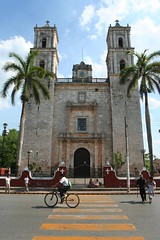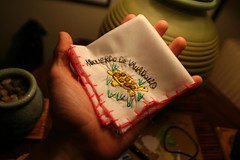 Palacio de la Luna was amazing in every aspect. Ashley and I were like little children seeing snow for the first time. Free drinks, meals, all-day tours... a jacuzzi and a two-headed shower in our very own massive suite complete with king sized bed, breakfast nook, veranda, Chez lounge, and room service. I digress too often. Like I said, I can barely shut myself up.
Palacio de la Luna was amazing in every aspect. Ashley and I were like little children seeing snow for the first time. Free drinks, meals, all-day tours... a jacuzzi and a two-headed shower in our very own massive suite complete with king sized bed, breakfast nook, veranda, Chez lounge, and room service. I digress too often. Like I said, I can barely shut myself up.Lavish as the resort was, it was the learning experience that I really don't want to forget. The real Mexico was revealed in many layers, though it seemed to whiz past our eyes through the windows of a tour bus.
 We witnessed the breathtaking ruins of ancient Mayan civilization established nearly 4000 years ago. These people had a a brilliant understanding of and appreciation for the cosmos. They understood the world they lived in to be alive as they are, something people today seem to forget or even ignore. The Mayan pyramid of Kukulcan in Chitzen Itza reflects this appreciation by functioning as both an astrological and fertility calendar. Not only did it track the position of our sun and the moon, their calendar also recognized the 260 day period of gestation.
We witnessed the breathtaking ruins of ancient Mayan civilization established nearly 4000 years ago. These people had a a brilliant understanding of and appreciation for the cosmos. They understood the world they lived in to be alive as they are, something people today seem to forget or even ignore. The Mayan pyramid of Kukulcan in Chitzen Itza reflects this appreciation by functioning as both an astrological and fertility calendar. Not only did it track the position of our sun and the moon, their calendar also recognized the 260 day period of gestation. At present, 3 million Mayans still live in the Yucatan Peninsula, and 4 million more throughout the rest of Mexico. So many people believe that the Mayans disappeared when the Spanish conquistadors came and destroyed their greatest cities, building churches out of the very ruins. I'll admit, I thought they were long gone, and yet there they were. Some live in huts in the jungle, weaving hammocks and working the land, others sell cheap souvenirs at tourist sites, and many were employed at the Moon Palace resort. Their native tongue is Mayan, a language that sounds nothing like Spanish, and has survived thousands of years. They will then learn Spanish in primary school and English in secondary. How many languages does the average American speak?
At present, 3 million Mayans still live in the Yucatan Peninsula, and 4 million more throughout the rest of Mexico. So many people believe that the Mayans disappeared when the Spanish conquistadors came and destroyed their greatest cities, building churches out of the very ruins. I'll admit, I thought they were long gone, and yet there they were. Some live in huts in the jungle, weaving hammocks and working the land, others sell cheap souvenirs at tourist sites, and many were employed at the Moon Palace resort. Their native tongue is Mayan, a language that sounds nothing like Spanish, and has survived thousands of years. They will then learn Spanish in primary school and English in secondary. How many languages does the average American speak? One of the towns we visited was called Valladolid. We were able to explore the central park and the shops etc. surrounding it. The park itself was beautiful, as was most of the center of town. Walk a block outside however, and the infrastructure becomes far less impressive. In this setting, I was truly able to feel the color of my skin, which is a rare occurrence for me because I live and work in such a culturally diverse place and I am anything but a minority. Caucasians in Valladolid are more likely to be tourists than a member of the local minority. This means that you cannot stroll down the street in white skin without street vendors and shop owners doing everything in their power to get your attention. "¡Mira, mira, mira!" "One dollar!" "More of these inside."
One of the towns we visited was called Valladolid. We were able to explore the central park and the shops etc. surrounding it. The park itself was beautiful, as was most of the center of town. Walk a block outside however, and the infrastructure becomes far less impressive. In this setting, I was truly able to feel the color of my skin, which is a rare occurrence for me because I live and work in such a culturally diverse place and I am anything but a minority. Caucasians in Valladolid are more likely to be tourists than a member of the local minority. This means that you cannot stroll down the street in white skin without street vendors and shop owners doing everything in their power to get your attention. "¡Mira, mira, mira!" "One dollar!" "More of these inside." I spent $2 in Valladolid on two hand-sewn handkerchiefs sold by a little girl in the park. I sat down on a wall to take a look at what designs she had made and was instantly surrounded by a bunch of girls. 5-10 years old, they were wide-eyed and silent, holding handkerchiefs, bracelets and other trinkets. An old woman slowly made her way closer holding some sort of large woven craft. I flipped through the handkerchiefs, and looked up at the girl in front of me, "¿Qué es esto?" I asked. "Es un elefante." "¡Elefante! ...hay muchos elefantes aqui?" I joked. She shook her head, with the slightest smile. Each of them had the words "RECUERDO DE VALLADOLID"... I pointed at the last word, and asked her how to pronounce it. "¿Cómo se dice?" "Bai-ah-do-leed" she said.
I spent $2 in Valladolid on two hand-sewn handkerchiefs sold by a little girl in the park. I sat down on a wall to take a look at what designs she had made and was instantly surrounded by a bunch of girls. 5-10 years old, they were wide-eyed and silent, holding handkerchiefs, bracelets and other trinkets. An old woman slowly made her way closer holding some sort of large woven craft. I flipped through the handkerchiefs, and looked up at the girl in front of me, "¿Qué es esto?" I asked. "Es un elefante." "¡Elefante! ...hay muchos elefantes aqui?" I joked. She shook her head, with the slightest smile. Each of them had the words "RECUERDO DE VALLADOLID"... I pointed at the last word, and asked her how to pronounce it. "¿Cómo se dice?" "Bai-ah-do-leed" she said.
No comments:
Post a Comment